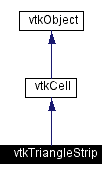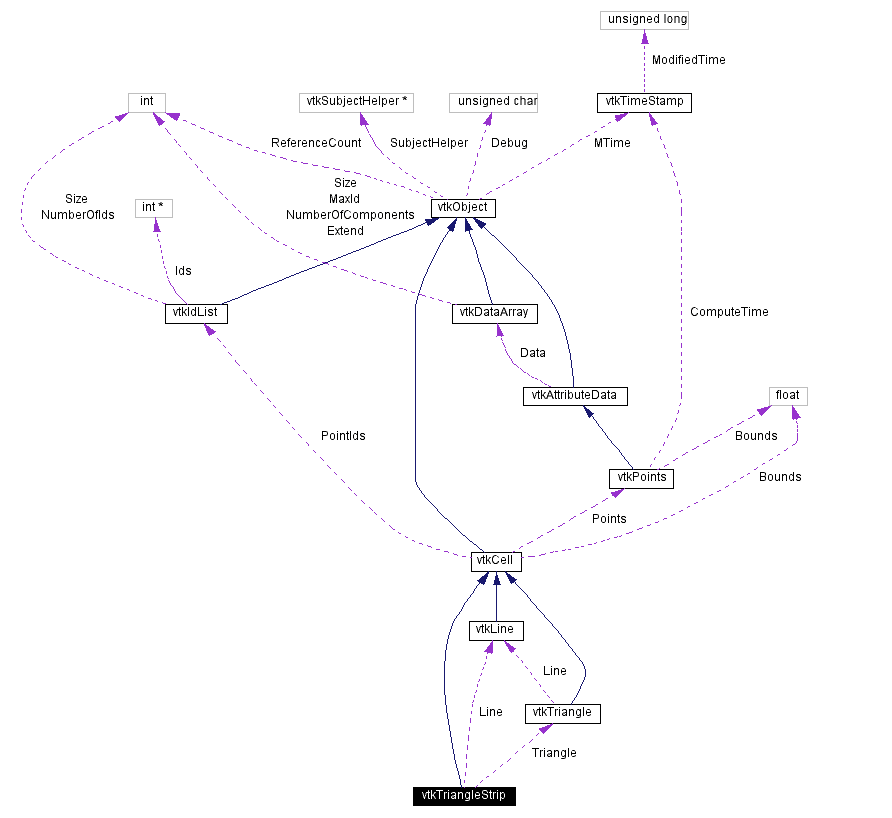
#include <vtkTriangleStrip.h>
Inheritance diagram for vtkTriangleStrip:


Public Methods | |
| virtual const char * | GetClassName () |
| virtual int | IsA (const char *type) |
| vtkCell * | MakeObject () |
| int | GetCellType () |
| int | GetCellDimension () |
| int | GetNumberOfEdges () |
| int | GetNumberOfFaces () |
| vtkCell * | GetEdge (int edgeId) |
| vtkCell * | GetFace (int vtkNotUsed(faceId)) |
| int | CellBoundary (int subId, float pcoords[3], vtkIdList *pts) |
| void | Contour (float value, vtkScalars *cellScalars, vtkPointLocator *locator, vtkCellArray *verts, vtkCellArray *lines, vtkCellArray *polys, vtkPointData *inPd, vtkPointData *outPd, vtkCellData *inCd, int cellId, vtkCellData *outCd) |
| void | Clip (float value, vtkScalars *cellScalars, vtkPointLocator *locator, vtkCellArray *polys, vtkPointData *inPd, vtkPointData *outPd, vtkCellData *inCd, int cellId, vtkCellData *outCd, int insideOut) |
| int | EvaluatePosition (float x[3], float *closestPoint, int &subId, float pcoords[3], float &dist2, float *weights) |
| void | EvaluateLocation (int &subId, float pcoords[3], float x[3], float *weights) |
| int | IntersectWithLine (float p1[3], float p2[3], float tol, float &t, float x[3], float pcoords[3], int &subId) |
| int | Triangulate (int index, vtkIdList *ptIds, vtkPoints *pts) |
| void | Derivatives (int subId, float pcoords[3], float *values, int dim, float *derivs) |
| int | GetParametricCenter (float pcoords[3]) |
| void | DecomposeStrip (int npts, int *pts, vtkCellArray *tris) |
| int | CellBoundary (int subId, float pcoords[3], vtkIdList &pts) |
| int | Triangulate (int index, vtkIdList &ptIds, vtkPoints &pts) |
Static Public Methods | |
| vtkTriangleStrip * | New () |
| int | IsTypeOf (const char *type) |
| vtkTriangleStrip * | SafeDownCast (vtkObject *o) |
Protected Methods | |
| vtkTriangleStrip () | |
| ~vtkTriangleStrip () | |
| vtkTriangleStrip (const vtkTriangleStrip &) | |
| void | operator= (const vtkTriangleStrip &) |
Protected Attributes | |
| vtkLine * | Line |
| vtkTriangle * | Triangle |
vtkTriangleStrip is a concrete implementation of vtkCell to represent a 2D triangle strip. A triangle strip is a compact representation of triangles connected edge to edge in strip fashion. The connectivity of a triangle strip is three points defining an initial triangle, then for each additional triangle, a single point that, combined with the previous two points, defines the next triangle.
Definition at line 64 of file vtkTriangleStrip.h.
|
|
|
|
|
|
|
|
Definition at line 119 of file vtkTriangleStrip.h. |
|
|
Create an object with Debug turned off, modified time initialized to zero, and reference counting on. Reimplemented from vtkObject. |
|
|
Return the class name as a string. This method is defined in all subclasses of vtkObject with the vtkTypeMacro found in vtkSetGet.h. Reimplemented from vtkCell. |
|
|
Return 1 if this class type is the same type of (or a subclass of) the named class. Returns 0 otherwise. This method works in combination with vtkTypeMacro found in vtkSetGet.h. Reimplemented from vtkCell. |
|
|
Return 1 if this class is the same type of (or a subclass of) the named class. Returns 0 otherwise. This method works in combination with vtkTypeMacro found in vtkSetGet.h. Reimplemented from vtkCell. |
|
|
Will cast the supplied object to vtkObject* is this is a safe operation (i.e., a safe downcast); otherwise NULL is returned. This method is defined in all subclasses of vtkObject with the vtkTypeMacro found in vtkSetGet.h. Reimplemented from vtkCell. |
|
|
See the vtkCell API for descriptions of these methods. Reimplemented from vtkCell. |
|
|
Return the type of cell. Reimplemented from vtkCell. Definition at line 72 of file vtkTriangleStrip.h. |
|
|
Return the topological dimensional of the cell (0,1,2, or 3). Reimplemented from vtkCell. Definition at line 73 of file vtkTriangleStrip.h. |
|
|
Return the number of edges in the cell. Reimplemented from vtkCell. Definition at line 74 of file vtkTriangleStrip.h. |
|
|
Return the number of faces in the cell. Reimplemented from vtkCell. Definition at line 75 of file vtkTriangleStrip.h. |
|
|
Return the edge cell from the edgeId of the cell. Reimplemented from vtkCell. |
|
|
Definition at line 77 of file vtkTriangleStrip.h. |
|
||||||||||||||||
|
Given parametric coordinates of a point, return the closest cell boundary, and whether the point is inside or outside of the cell. The cell boundary is defined by a list of points (pts) that specify a face (3D cell), edge (2D cell), or vertex (1D cell). If the return value of the method is != 0, then the point is inside the cell. Reimplemented from vtkCell. |
|
||||||||||||||||||||||||||||||||||||||||||||||||
|
Generate contouring primitives. The scalar list cellScalars are scalar values at each cell point. The point locator is essentially a points list that merges points as they are inserted (i.e., prevents duplicates). Contouring primitives can be vertices, lines, or polygons. It is possible to interpolate point data along the edge by providing input and output point data - if outPd is NULL, then no interpolation is performed. Also, if the output cell data is non-NULL, the cell data from the contoured cell is passed to the generated contouring primitives. (Note: the CopyAllocate() method must be invoked on both the output cell and point data. The cellId refers to the cell from which the cell data is copied.) Reimplemented from vtkCell. |
|
||||||||||||||||||||||||||||||||||||||||||||
|
Cut (or clip) the cell based on the input cellScalars and the specified value. The output of the clip operation will be one or more cells of the same topological dimension as the original cell. The flag insideOut controls what part of the cell is considered inside - normally cell points whose scalar value is greater than "value" are considered inside. If insideOut is on, this is reversed. Also, if the output cell data is non-NULL, the cell data from the clipped cell is passed to the generated contouring primitives. (Note: the CopyAllocate() method must be invoked on both the output cell and point data. The cellId refers to the cell from which the cell data is copied.) Reimplemented from vtkCell. |
|
||||||||||||||||||||||||||||
|
Given a point x[3] return inside(=1) or outside(=0) cell; evaluate parametric coordinates, sub-cell id (!=0 only if cell is composite), distance squared of point x[3] to cell (in particular, the sub-cell indicated), closest point on cell to x[3] (unless closestPoint is null, in which case, the closest point and dist2 are not found), and interpolation weights in cell. (The number of weights is equal to the number of points defining the cell). Note: on rare occasions a -1 is returned from the method. This means that numerical error has occurred and all data returned from this method should be ignored. Also, inside/outside is determine parametrically. That is, a point is inside if it satisfies parametric limits. This can cause problems for cells of topological dimension 2 or less, since a point in 3D can project onto the cell within parametric limits but be "far" from the cell. Thus the value dist2 may be checked to determine true in/out. Reimplemented from vtkCell. |
|
||||||||||||||||||||
|
Determine global coordinate (x[3]) from subId and parametric coordinates. Also returns interpolation weights. (The number of weights is equal to the number of points in the cell.) Reimplemented from vtkCell. |
|
||||||||||||||||||||||||||||||||
|
Intersect with a ray. Return parametric coordinates (both line and cell) and global intersection coordinates, given ray definition and tolerance. The method returns non-zero value if intersection occurs. Reimplemented from vtkCell. |
|
||||||||||||||||
|
Generate simplices of proper dimension. If cell is 3D, tetrahedron are generated; if 2D triangles; if 1D lines; if 0D points. The form of the output is a sequence of points, each n+1 points (where n is topological cell dimension) defining a simplex. The index is a parameter that controls which triangulation to use (if more than one is possible). If numerical degeneracy encountered, 0 is returned, otherwise 1 is returned. Reimplemented from vtkCell. |
|
||||||||||||||||||||||||
|
Compute derivatives given cell subId and parametric coordinates. The values array is a series of data value(s) at the cell points. There is a one-to-one correspondence between cell point and data value(s). Dim is the number of data values per cell point. Derivs are derivatives in the x-y-z coordinate directions for each data value. Thus, if computing derivatives for a scalar function in a hexahedron, dim=1, 8 values are supplied, and 3 deriv values are returned (i.e., derivatives in x-y-z directions). On the other hand, if computing derivatives of velocity (vx,vy,vz) dim=3, 24 values are supplied ((vx,vy,vz)1, (vx,vy,vz)2, ....()8), and 9 deriv values are returned ((d(vx)/dx),(d(vx)/dy),(d(vx)/dz), (d(vy)/dx),(d(vy)/dy), (d(vy)/dz), (d(vz)/dx),(d(vz)/dy),(d(vz)/dz)). Reimplemented from vtkCell. |
|
|
Return the center of the point cloud in parametric coordinates. Reimplemented from vtkCell. |
|
||||||||||||||||
|
Given a triangle strip, decompose it into a list of (triangle) polygons. The polygons are appended to the end of the list of triangles. |
|
||||||||||||||||
|
For legacy compatibility. Do not use. Definition at line 109 of file vtkTriangleStrip.h. |
|
||||||||||||||||
|
Definition at line 111 of file vtkTriangleStrip.h. |
|
|
Definition at line 120 of file vtkTriangleStrip.h. |
|
|
Definition at line 122 of file vtkTriangleStrip.h. |
|
|
Definition at line 123 of file vtkTriangleStrip.h. |
 1.2.11.1 written by Dimitri van Heesch,
© 1997-2001
1.2.11.1 written by Dimitri van Heesch,
© 1997-2001